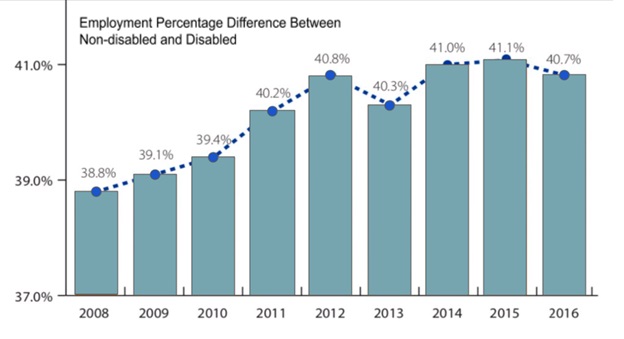Even as the global standards of life for many people continue to be improved drastically with the progression of the 21st century, the needs of minority groups are often dismissed, causing them to fall into poverty. Currently, in the United States, around 12.7% of citizens are in poverty, converting to nearly 40.6 million people. However, while many organizations and groups focus on the topic of poverty as a whole, they often forget to include benefits for minorities and specific groups of people. One significant group that is overlooked are the disabled.
According to the 2016 Disability Statistics Annual Report, around 21.0% of people with a disability are in poverty, but more recent and in-depth research conducted on the socioeconomic status of the disabled further illustrates the apparent correlation between the disabled and poverty. It is imperative to address this issue now, as the disability rates of citizens of the United States continue to grow exponentially, with disability rates reaching over 12.8%, or nearly 5.75 million people.
However, even with the thorough and direct evidence clearly displaying the state of the disabled, both societal and governmental issues continue to deteriorate their quality of life.
Negligence by the US government has contributed to the consistent employment gap between the enabled and disabled, resulting in stagnant employment trends for the latter. While the past decade has seen a substantial number of cases illustrating the issue of unemployment in the disabled population, the US government has merely passed a single law to protect the employment needs of the physically disabled: the Americans with Disability Act (ADA). This law supposedly outlines the standards of protection that the disabled may receive in terms of employment, earnings, and workplace attitudes.

[Source: Graph created by Author, Seonghyeon Sean Lee]
These inconsistencies in the ADA shed light on why the employment rates of the disabled have remained stagnant since its establishment in 1990. According to the Current Population Survey (CPS), a monthly sample survey regarding employment of 60,000 households, the 2017 unemployment rate for the disabled was 9.2%, rising steadily annually. These unemployment rates are similar to the unemployment rate of the disabled during the time period of the establishment of the ADA, which ranged from 8.7% to 8.9%.
Hence, the stationary unemployment rates from 1990 to 2017 not only verifies that the US government has remained blind to the issues regarding the physically disabled but also justifies the uselessness of the ADA in employment for the disabled, consequently inhibiting the development of the disabled stuck in states of poverty and troublesome conditions.

[Source: Graph created by Author, Seonghyeon Sean Lee]
This is also true for developed countries, including the United States. However, this surge in population raises the costs of rent and overall costs of living, such as utility fees for water and electricity. According to the Mardi Yatrix, which documents rent prices in the US, 93% of the largest 252 cities in the United States has seen average city rent price increase compared to the average of October 2017.
The general population of the US may be indifferent to this change, as the national annual average paycheck rounds to $32,479, but for the disabled, this negative modification of rent prices is detrimental, as their low annual wage of $22,047 does not allow for comfort or safety.

[Source: Graphic created by Author, Seonghyeon Sean Lee]
Not only did the disabled have a turnover rate that was 48 percent lower than that of the non-disabled population, but their medical costs were 67 percent lower and time-off expenses were 73 percent lower. Other studies showed significant benefits to hiring disabled employees, one of which allowed growth in customers as 92 percent of consumers favored companies with disabled employees.

[Source: Graph created by Author, Seonghyeon Sean Lee]
In order to support the disabled and help them rise out of poverty, it is crucial that many employers begin to consider work-at-home jobs for employees and continue to employ the disabled, as it proves to not only be beneficial for the disabled but also the employers.
Seonghyeon Sean Lee, Grade 12
North Hollywood Highly Gifted Magnet School

